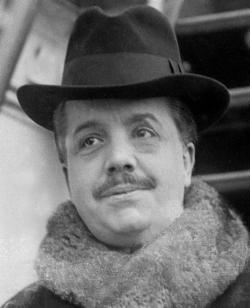The following is an excerpt from James Wolcott’s Kindle Single, Wild in the Seats, which comes out this week. Buy it here.

Courtesy of George Grantham Bain Collection/Library of Congress/Wikipedia
To most Americans, spring is a swaying season of greening and blossoming, a Terrence Malick beauty pageant of the great outdoors where every bee, bird, and blade of grass plays its lyric part, an extended Easter that is all resurrection, no crucifixion. But the composer Igor Stravinsky was Russian, and the Russian springs of his youth meant business.
His symphony Le Sacre du Printemps (The Rite of Spring) was inspired by “the violent Russian spring that seemed to begin in an hour and was like the whole Earth cracking.” The poet, filmmaker, artist, and novelist Jean Cocteau—the James Franco of his day, only incalculably more adept—wrote that Stravinsky himself fissured the landscape. “Painters vied with each other to find new ways of being misty and melting … then, suddenly, in the midst of these charming ruins, sprang up the tree Stravinsky. The result was a work that is, and will remain, a masterpiece; a symphony impregnated with a wild pathos, with earth in the throes of birth, noises of farm and camp, little melodies that come to us out of the depths of the centuries, the panting of cattle, profound convulsions of nature, prehistoric georgics.”
Cocteau was right in his masterpiece prophecy. But it is not just as a symphony brooding out of stereo speakers or concert halls that Le Sacre du Printemps is remembered, but as a dance that tore away the tulle and tiara of ballet and dragged it both quixotically forward and primevally back. And, most of all, as an Event.
The premiere of the Ballet Russes production of Le Sacre du Printemps in Paris on May 29, 1913, triggered modernism’s greatest earthquake, and a century later the convulsions are still being seen, heard, felt. The rough beast continues to rear its rumbling head.
As with any earthquake, the plates had been shifting, the pressures building, and the opposing forces preparing to rumble before the eruption occurred. Under the magus impresario-ship of Serge Pavlovich Diaghilev, the Ballet Russes had thrilled and titillated the beau monde of Europe since docking in Paris in 1909; it had become a multidirectional tastemaker. Born in Russia in 1872, Diaghilev attended the St. Petersburg Conservatory; his chief passion was opera, but he had a magpie zeal for all of the arts and flourishes (painting, theater, dance, literature, scene design, fashion) and a genius for publicity that wouldn’t be matched until the advent of Andy Warhol and the pop cult of celebrity. Of course, Diaghilev worked on a much larger scale than Warhol (whose star factory was held together with black tape and tinfoil), a grand ballroom and cathedral scale, his productions aspiring to the Wagnerian ideal of Gesamtkunstwerk, the Total Work of Art where dance, music, myth, and spectacle synthesized, unified, and birthed a new thundering cosmos.
Although Diaghilev comported himself as a dandy, with his monocle, white gloves, dyed black hair with skunk streak, and top hat (two decades later and he could have been the perfect foil in a Fred Astaire-Ginger Rogers musical), he had the determination and tactical acumen of a general. Art for him wasn’t a sphere of contemplation; it was a public event intended to excite what the sociologist Émile Durkheim called “l’effervescence sociale.” It wasn’t enough to get newspaper coverage; you had to become the topic of excited conversation among what would later be labeled “the influentials.” And these jaded elegants weren’t going to be stimulated by the same melting, yearning pantomime in pointe shoes, no matter how skillfully performed. Their expectations had to be rattled and thrown like a pair of dice.
Diaghilev didn’t shy away from controversy. A polished provocateur, an upper-crusty P.T. Barnum (a 2009 exhibition of Ballet Russes memorabilia was titled “Diaghilev’s Theater of Marvels,” very Barnum-esque), he invited it, reveled in it—it was vitalizing. “Etonne-moi!” Diaghilev would instruct Cocteau when he set about to write the scenario for the ballet Parade (designed by Picasso)—“Astonish me!” Astonishment begins in the eyes, with a pop of wonder, but The Rite of Spring went for the solar plexus, leaving much of the opening night audience not so much astonished as aghast.
“Even before the curtain went up on Roerich’s barren, ‘prehistoric’ scenery, only a few minutes into the score, the fidgeting began at the sound of Stravinsky’s craggy, layered introductory music,” Charles M. Joseph writes in his study Stravinsky’s Ballets. “The audience’s agitation quickly escalated as the curtain rose, revealing Roerich’s garishly costumed dancers. Such a sight could not have been anything close to what the audience might have anticipated. And to exacerbate their discomfort, the dancers began their relentless jumping to the brutally repetitive ‘Augurs of Spring.’ Each one of Stravinsky’s accented ostinato chords was driven downward into the stage, like so many implanted stakes, by feet-thumping peasants made to pass as ballet dancers.” Peasants in bearskins, no less!
“The audience played the role it had to play; it immediately rebelled,” records Cocteau. “It laughed, scoffed, whistled, hissed and cat-called, and perhaps might have gotten tired in the long run if it had not been for excessive zeal of the esthetes and a few musicians who insulted and even jostled the people in the boxes. The uproar degenerated in a free-for-all … ” Diaghilev had to order the house lights turned on and off to quell the native uprising, but after a lull, there would be a fresh resurgence of audience mutiny.